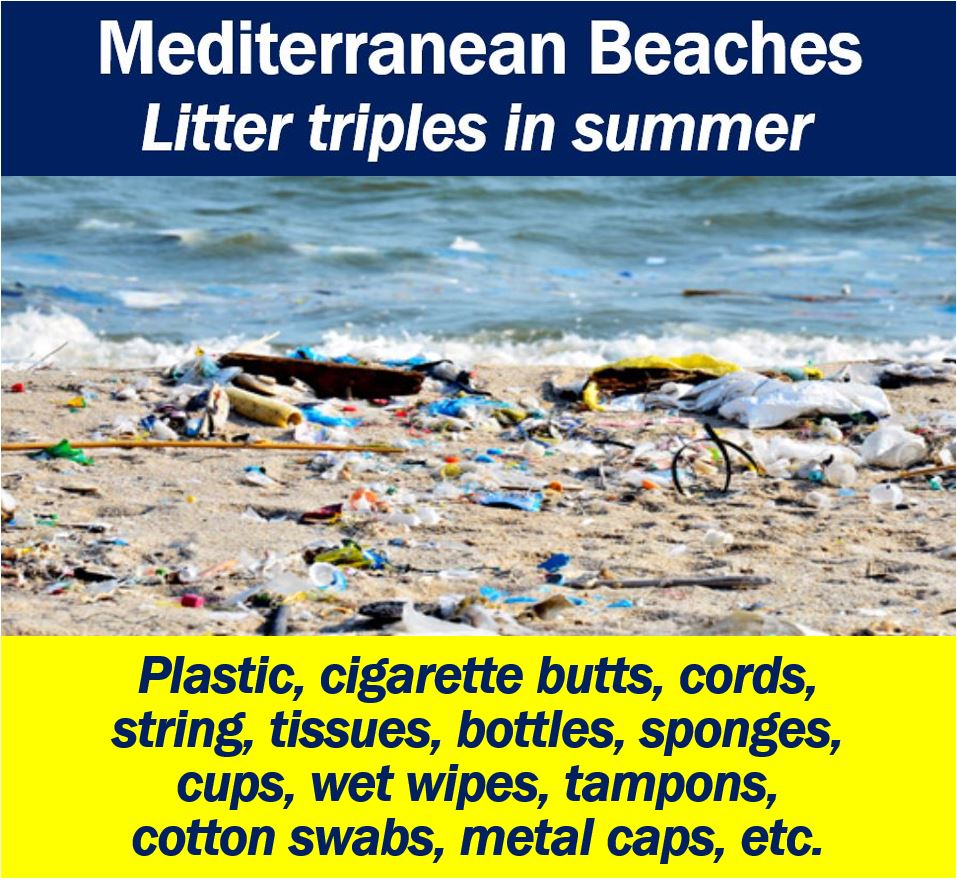During the summer months, Mediterranean beaches have triple the amount of marine litter. Specifically, three times the amount compared to the other months of the year. This is what researchers from the Institute of Environmental Science and Technology of the Universitat Autònoma de Barcelona (ICTA-UAB) found.
The researchers analyzed and quantified waste that tourists generated in eight Mediterranean islands. They analyzed the beaches of Crete, Cyprus, Mallorca, Sicily, Malta, Rab, Rhodes, and Mykonos. Their study was part of the European BLUEISLANDS Project.
Cigarette butts and plastic litter were the main problems on the beaches they monitored.
During the summer, there are 250,000 (average) items of litter per day for every square kilometer of Mediterranean beaches.
Overall, Mediterranean beaches experience three times the amount of litter during the summer. However, in some beaches, the amount of litter may increase seven-fold.
Much of the beach litter ends up in the sea, thus exacerbating another problem – water pollution.

Mediterranean beaches – tourists
Mediterranean beaches get more tourists than any major beach area globally. The Mediterranean islands, especially, receive a huge number of visitors in July and August. Specifically, during the school summer vacations (UK: summer holidays).
Tourism is a major source of income and generator of jobs for the local economies.
However, tourists gather in massive numbers over a relatively short period. This places a serious burden on local infrastructures.
The sheer volume of waste regularly overwhelms local waste management services.
Local authorities in charge of Mediterranean beaches are seeking ways to address this annual problem. They also need to get tourists to dispose of their waste selectively.
Mitigating seasonal increase of waste
The European Interreg MED BLUEISLANDS Project aims to develop and create efficient ways to mitigate the seasonal increase of waste.
They must also make sure that their measures are economically viable and environmentally sustainable.
The study comprised 147 separate analyses of marine litter on the beaches of the Mediterranean islands. The researchers measured levels of waste during the high and low seasons.
They tried to determine what the impact was on coastlines and several Mediterranean beaches. Their aim was also to determine what effect all this had on wastewater treatment facilities.
Mediterranean beaches – low/high seasons
The 250,000 items of litter per day per square kilometer figure was the average for the May-to-September period. In July and August, the figure was even higher – 316,000 items of litter per day.
During the low season, on the other hand, litter volumes averaged 81,000 items per day.
Three types of beaches
The researchers analyzed three types of Mediterranean beaches during the summer months:
– Tourist beaches with lots of hotels, restaurants and beach bars. These had extensive infrastructures. In July, these beaches accumulated, on average, 450,000 items of litter per day.
– Popular beaches that local residents used. These had few services. In July, these beaches accumulated 300,000 items of litter per day.
– Remote beaches with no services at all. These accumulated 200,000 items of litter per day, also in July.
How clean or dirty the beaches were depended on how often cleaners came round.
Sand cleaning machines, for example, passed along the busiest beaches every day. However, they only cleaned the local beaches once every two days.
The cleaning frequency in remote beaches varied significantly. Some of these beaches were extremely difficult for large cleaning machines to get to.
Types of waste
Most of the litter that the researchers found on Mediterranean beaches consisted of plastics and cigarette butts. They made up 36.8% and 30.6% of all litter respectively.
Microplastics, mesoplastics, and macroplastics represented 9.3%, 19.8% and 7.7% of total waste respectively.
Microplastics measure less than 0.5cm, mesoplastics 0.5 to 2.5cm, and macroplastics more than 2.5cm.
Other items of waste included cords, string, tissues, glass bottles, sponges, cups, wet wipes, and tampons. The researchers also reported cotton swabs, miscellaneous glass, and metal caps.
Regarding pellets, ICTA-UAB researcher Michael Grelaud said:
“It is worth highlighting that the pellets, the small round pieces of plastic used to manufacture a variety of things, are not left on the beach by tourists, but arrive through industries.”
“There are several production companies in the Mediterranean region, and it is possible that they end up in the sea after being dumped or lost by freight carriers.”
Mediterranean beaches vary
Some beaches had more litter than others. Beaches in Malta, the researchers found, had the greatest accumulation of marine litter. Below is a list of the beaches with the most items of litter per square kilometer per day during the high season:
– Malta 600,000.
– Mallorca (Spain) 400,000.
– Rab (Croatia) 270,000.
– Cyprus 113,000.
The cleanest beaches, on the other hand, had significantly lower volumes:
– Mykonos (Greece) 8,700.
– Sicily (Italy) 29,000.
– Rhodes (Greece) 66,000.
The Universitat Autònoma de Barcelona said the following regarding the BLUEISLANDS Project:
“The BLUEISLANDS project aims to provide answers to all these concerns. Based on the results obtained, researchers will propose solution strategies to fight against the problem.”
“After applying the measures, the surveys will be repeated in order to assess their impact.”
